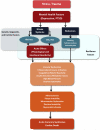Behavioral, emotional and neurobiological determinants of coronary heart disease risk in women
- PMID: 27496672
- PMCID: PMC5290226
- DOI: 10.1016/j.neubiorev.2016.04.023
Behavioral, emotional and neurobiological determinants of coronary heart disease risk in women
Abstract
Women have more of the stress-related behavioral profile that has been linked to cardiovascular disease than men. For example, women double the rates of stress-related mental disorders such as depression and posttraumatic stress disorder (PTSD) than men, and have higher rates of exposure to adversity early in life. This profile may increase women's long-term risk of cardiometabolic conditions linked to stress, especially coronary heart disease (CHD). In addition to having a higher prevalence of psychosocial stressors, women may be more vulnerable to the adverse effects of these stressors on CHD, perhaps through altered neurobiological physiology. Emerging data suggest that young women are disproportionally susceptible to the adverse effects of stress on the risk of cardiovascular disease, both in terms of initiating the disease as well as worsening the prognosis in women who have already exhibited symptoms of the disease. Women's potential vulnerability to psychosocial stress could also help explain their higher propensity toward abnormal coronary vasomotion and microvascular disease compared with men.
Keywords: Stress; cardiovascular disease; gender factors; mental health; women.
Copyright © 2016 Elsevier Ltd. All rights reserved.
Figures


Similar articles
-
[Posttraumatic stress disorder (PTSD) as a consequence of the interaction between an individual genetic susceptibility, a traumatogenic event and a social context].Encephale. 2012 Oct;38(5):373-80. doi: 10.1016/j.encep.2011.12.003. Epub 2012 Jan 24. Encephale. 2012. PMID: 23062450 Review. French.
-
Gender differences in the effects of deployment-related stressors and pre-deployment risk factors on the development of PTSD symptoms in National Guard Soldiers deployed to Iraq and Afghanistan.J Psychiatr Res. 2014 Feb;49:1-9. doi: 10.1016/j.jpsychires.2013.09.016. Epub 2013 Oct 5. J Psychiatr Res. 2014. PMID: 24290487
-
Creating opportunities for parent empowerment: program effects on the mental health/coping outcomes of critically ill young children and their mothers.Pediatrics. 2004 Jun;113(6):e597-607. doi: 10.1542/peds.113.6.e597. Pediatrics. 2004. PMID: 15173543 Clinical Trial.
-
Psychosocial factors of coronary heart disease in women: a review.Soc Sci Med. 1996 May;42(10):1351-65. doi: 10.1016/0277-9536(95)00284-7. Soc Sci Med. 1996. PMID: 8735892 Review.
-
The Role of Psychosocial Stress on Cardiovascular Disease in Women: JACC State-of-the-Art Review.J Am Coll Cardiol. 2024 Jul 16;84(3):298-314. doi: 10.1016/j.jacc.2024.05.016. J Am Coll Cardiol. 2024. PMID: 38986672 Free PMC article. Review.
Cited by
-
Higher arterial stiffness and blunted vagal control of the heart in young women with compared to without a clinical diagnosis of PTSD.Clin Auton Res. 2024 Feb;34(1):165-175. doi: 10.1007/s10286-024-01014-7. Epub 2024 Feb 7. Clin Auton Res. 2024. PMID: 38324188
-
Brain-heart connections in stress and cardiovascular disease: Implications for the cardiac patient.Atherosclerosis. 2021 Jul;328:74-82. doi: 10.1016/j.atherosclerosis.2021.05.020. Epub 2021 May 30. Atherosclerosis. 2021. PMID: 34102426 Free PMC article. Review.
-
Posttraumatic stress disorder, diurnal cortisol, and ambulatory blood pressure in early and late pregnancy.J Trauma Stress. 2023 Feb;36(1):239-246. doi: 10.1002/jts.22895. Epub 2022 Dec 4. J Trauma Stress. 2023. PMID: 36464928 Free PMC article.
-
Diet, Stress and Mental Health.Nutrients. 2020 Aug 13;12(8):2428. doi: 10.3390/nu12082428. Nutrients. 2020. PMID: 32823562 Free PMC article. Review.
-
Site-Specific knockdown of microglia in the locus coeruleus regulates hypervigilant responses to social stress in female rats.Brain Behav Immun. 2023 Mar;109:190-203. doi: 10.1016/j.bbi.2023.01.011. Epub 2023 Jan 20. Brain Behav Immun. 2023. PMID: 36682513 Free PMC article.
References
-
- Adverse Childhood Experiences Reported by Adults—Five States, 2009. MMWR. Morb. Mortal. Wkly. Rep. 2010;59(49):1609–1613. - PubMed
-
- Ahmadi N, Hajsadeghi F, Mirshkarlo HB, Budoff M, Yehuda R, Ebrahimi R. Post-traumatic stress disorder, coronary atherosclerosis, and mortality. Am. J. Cardiol. 2011;108(1):29–33. - PubMed
-
- Albert CM, Chae CU, Rexrode KM, Manson JE, Kawachi I. Phobic anxiety and risk of coronary heart disease and sudden cardiac death among women. Circulation. 2005;111(4):480–487. - PubMed
-
- Alonso J, Angermeyer MC, Bernert S, Bruffaerts R, Brugha TS, Bryson H, de Girolamo G, Graaf R, Demyttenaere K, Gasquet I, Haro JM, Katz SJ, Kessler RC, Kovess V, Lepine JP, Ormel J, Polidori G, Russo LJ, Vilagut G, Almansa J, Arbabzadeh-Bouchez S, Autonell J, Bernal M, Buist-Bouwman MA, Codony M, Domingo-Salvany A, Ferrer M, Joo SS, Martinez-Alonso M, Matschinger H, Mazzi F, Morgan Z, Morosini P, Palacin C, Romera B, Taub N, Vollebergh WA, EsemeD/Mhedea Investigators, European Study of the Epidemiology of Mental Disorders Project Prevalence of mental disorders in Europe: results from the European study of the epidemiology of mental disorders (ESEMeD) project. Acta Psychiatr. Scand. Suppl. 2004;420:21–27. - PubMed
-
- American Psychiatric Association . Diagnostic and Statistical Manual of Mental Disorders. 5th ed. American Psychiatric Association; Arlington, VA: 2013.
Publication types
MeSH terms
Grants and funding
LinkOut - more resources
Full Text Sources
Other Literature Sources

